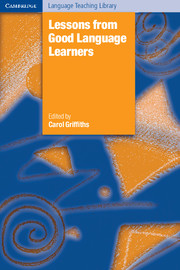Book contents
- Frontmatter
- Contents
- List of contributors
- Acknowledgements
- Editor's overview
- Prologue
- Reflections
- Part I Learner variables
- 1 Motivation and good language learners
- 2 Age and good language learners
- 3 Learning style and good laguage learners
- 4 Personality and good language learners
- 5 Gender and good language learners
- 6 Strategies and good language learners
- 7 Metacognition and good language learners
- 8 Autonomy and good language learners
- 9 Beliefs and good language learners
- 10 Culture and good language learners
- 11 Aptitude and good language learners
- Part II Learning variables
- The learners' landscape and journey: a summary
- Index
5 - Gender and good language learners
Published online by Cambridge University Press: 11 August 2009
- Frontmatter
- Contents
- List of contributors
- Acknowledgements
- Editor's overview
- Prologue
- Reflections
- Part I Learner variables
- 1 Motivation and good language learners
- 2 Age and good language learners
- 3 Learning style and good laguage learners
- 4 Personality and good language learners
- 5 Gender and good language learners
- 6 Strategies and good language learners
- 7 Metacognition and good language learners
- 8 Autonomy and good language learners
- 9 Beliefs and good language learners
- 10 Culture and good language learners
- 11 Aptitude and good language learners
- Part II Learning variables
- The learners' landscape and journey: a summary
- Index
Summary
Gender and its impact upon the ways that the sexes think, reason, and solve problems is once more becoming a hot topic in the popular press, and like any hot topic, it is at once fascinating and controversial. With the help of technology, the last five years of research on the male and female brain have given new insight into differences in their development and modes of information processing (Tyre, 2005). In this chapter we are interested not so much in gender differences per se, but in the processes that may contribute to bringing about a language performance differential between boys and girls, women and men. For language educators interested in enhancing the achievement of learners, it is certainly interesting to note that quantitative studies show boys and girls behaving in “strikingly different ways” (Dörnyei, 2005, p. 59).
It is those “different ways” which are the focus of research which seeks to tease out the contribution of gender in the complex array of factors that impact all learning and language learning and pedagogy in particular. Some factors are related to our human state and traits, and others are environmental or situational, dependent on the context or setting.
As educators, our departure point has to include the realization that our own socialized views of gender differences will impact our teaching and judgments.
- Type
- Chapter
- Information
- Lessons from Good Language Learners , pp. 73 - 82Publisher: Cambridge University PressPrint publication year: 2008
- 12
- Cited by



